Childhood obesity peaked in lockdown. Today, it remains above pre-pandemic levels. So do our packed lunches need to change?
Downloads
-
Focus On Lunchbox kids
PDF, Size 19.67 mb
The difference between healthy and unhealthy lunch prices is like night and day. On average, the top five retailers charge 43% more for healthier lunch items like wholemeal bread, cheese and fruit versus less healthy items like white bread, crisps and biscuits, recent analysis by The Food Foundation shows.
That means parents pay an average £3 premium to pack healthier lunches for a week, says the charity. It is calling on Tesco, Sainsbury’s, Asda, Aldi and Morrisons to introduce multibuys and meal deals on healthier packed lunch items to level the field.
“Our polling found that 64% of low-income families would find it helpful if retailers offered a lunchbox meal deal so they can easily buy items to make a week of healthy lunches,” says Food Foundation policy & advocacy manager Shona Goudie. “No retailer has such a deal.”
“64% of low-income families would find it helpful if retailers offered a lunch deal”
While it may be true that nutrition is too complex to make binary distinctions such as “healthy” and “unhealthy”, the fact remains: 22.7% of year-six kids in England were obese last year, up from 21% pre-pandemic [NHS].
Diet clearly plays a role, but to what extent are packed lunches fuelling childhood obesity? And what are retailers and their suppliers doing to make the food and drinks that fill kids’ lunchboxes more nutritious?
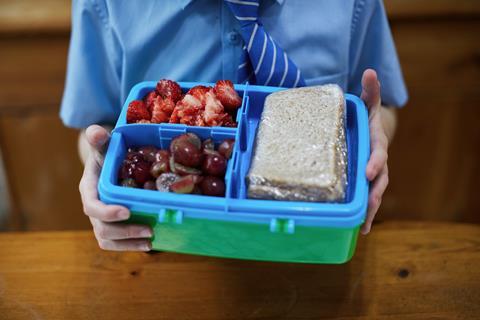
The first thing to note is the packed lunch market is growing. Children have eaten packed lunches on 323 million occasions in the past year, a 5.4% year-on-year rise [Kantar 52 w/e 17 March 2024]. That makes it even more important for the food in those lunchboxes to be good for them.
But that’s rarely the case, says The Food Foundation. The charity cites a 2016 study that found just 1.6% of primary school packed lunches met the nutritional standards set for meals served at school canteens [School of Food Science and Nutrition].
“Over a million children are in danger of poor development because they lack key nutrients”
Despite these findings and the health premium identified by The Food Foundation, the supers insist they’re making it easier for shoppers to make healthier choices. But when asked, none said they had plans to implement the promotions called for by the charity.
“We want to make good food affordable for everyone and are committed to offering a wide range of healthy lunchbox options at great value,” says a Sainsbury’s spokeswoman. She adds that the retailer ceased multibuy deals on high fat, salt and sugar (HFSS) lines in 2016.
A spokesman for Aldi, which The Food Foundation identifies as having the widest price variance between healthy and unhealthy lunch items (£10.08 versus £5.68), says: “We offer a wide selection of healthy, affordable food including fresh British fruit & vegetables.”
The charity identifies Tesco as having the narrowest difference, at £8.56 versus £7.82. A Tesco spokesperson explains: “We want to be the most convenient place to shop for healthy, more sustainable food at an affordable price, and we know how important it is for children to have a healthy, balanced diet.”
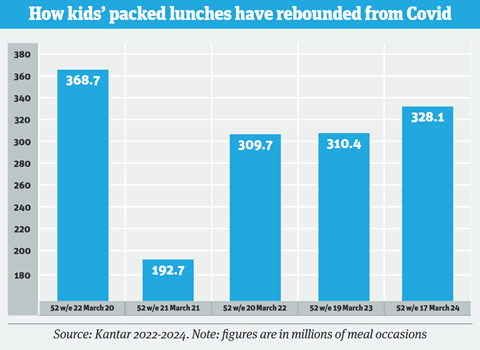
Kids in the UK have eaten packed lunches on 328.1 million occasions in the past year. That’s a year-on-year increase of 17.7 million occasions, or 5.7%, and the greatest total since the year of the first lockdown.
Not surprisingly, the number of packed lunch occasions fell off a cliff in the 52 weeks ending 21 March 2021, as schools faced shutdowns due to Covid. Occasions have been steadily recovering since, but have not reached pre-pandemic levels.
Children aged between 10 and 15 consume the most packed lunches among under-16s, having eaten from their lunchboxes on 172.3 million occasions in the past year, up 3.0% on the previous year.
Five to nine-year-olds are the next most significant age group when it comes to kids’ packed lunches. This age group tucked into 105 million packed lunches, up 4% on the previous year. Kids aged four to seven are entitled to free lunches at primary schools in England, but calls are growing for this to be extended to all primary school pupils.
Sandwiches rule supreme in kids’ lunchboxes, featuring in 66.0% of packed lunch occasions. Chicken is the most popular meal centre.
Kantar’s Worldpanel FMCG service monitors consumer behaviour across Great Britain. Its primary panel tracks take-home purchases of 30,000 demographically representative households. Data on consumption habits, nutrition and out of home sales is collected through subsidiary panels. Visit kantarworldpanel.com for details.
Falling standards
Even if these options are affordable, getting kids to eat healthily can be an uphill struggle. Research by The Grocer for Yoplait in April found taste, not health, is parents’ top consideration when deciding on snacks for their kids. Fifty-four per cent of about 1,000 parents polled rated taste as most important, followed by low sugar content at 43%, and suitability for school lunchboxes at 32% [Toluna/Harris Interactive].
Yet most parents also believed nutritional standards are falling. Nearly half (48%) said their kids’ diets were less healthy than theirs when they were young. Twenty-four per cent thought they were more or less the same, and 28% thought their kids ate more healthily than they did at the same age. That’s affecting more than kids’ waistlines.
“Children’s health is in crisis,” says Ewa Moxham, UK head of marketing at Yoplait. “Obesity rates are alarmingly high, particularly since the pandemic, and now affect a quarter to a third of children depending on age. What’s more, over a million children are in danger of poor development and growth because they lack key nutrients like calcium and vitamin D.”
“Levels of processing and nutritional values are not a binary. Consumers need clarity, and fast”
The problem is exacerbated by confusing and often contradictory messages about healthy eating and ultra-processed foods (UPFs), says Tor Hunt-Taylor, marketing director at the Collective Dairy. “There’s a lot of confusion around UPFs because they are not clearly researched or defined and, crucially, nutritional values are often not considered,” she says.
“Levels of processing and nutritional values are not a binary… Consumers need clarity, and fast, as there is arguably a public health risk of misinformation causing children or adults [to switch] to less processed diets that have lower nutrient profiles.”
To stay healthy and grow properly, children should exercise regularly and consume a mix of carbohydrates, protein, fat, fibre, vitamins, minerals and water, says the NHS. It also recommends that kids and adults should eat five or more portions of fruit & veg a day.
Many are not achieving this balance. NHS hospital data for England and Wales obtained by The Guardian in December revealed more than 800,000 people were admitted for malnutrition and nutrient deficiencies in the previous year. This represents a three-fold increase in diagnoses linked to poor diet in a decade, the paper reported.
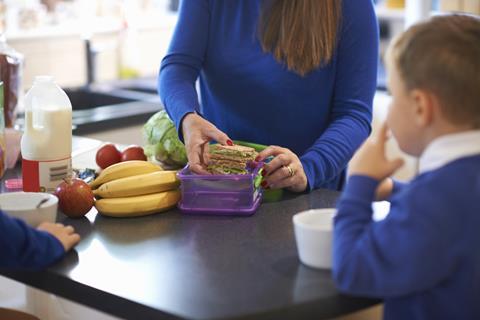
The sugar debate
When it comes to obesity, health campaigners have laid much of the blame at the door of sugar content. Yet some in the industry are arguing for greater nuance here.
“Within kids’ yoghurt,It’s important to point out that there are two types of sugar and too often they’re unhelpfully grouped together,” says Moxham at Yoplait.
Its Petits Filous Fromage Frais has been branded unhealthy by The Food Foundation because of its relatively high sugar content, for example. But not all sugars are equal.
“You have natural sugars, such as lactose from milk and the fruit sugars that come from adding fruit purée. On the other hand, you have free sugars, which you add. In two small pots of Petits Filous Fromage Frais, 2.5g is natural sugar from milk.”
That leaves a further 6.3g of what the NHS calls “free sugars”. This definition includes added sugars and those that naturally occur in honey, syrups and fruit juice, but not natural sugars from milk, fruit and vegetables.
The NHS says kids aged seven to 10 should have no more than 24g of free sugars a day; those aged four to six should have no more than 19g.
But Moxham believes “there must be a balance between yoghurts’ small sugar contribution to a daily diet and their significant contribution to positive fortified nutrients, such as calcium and vitamin D, which are critical to children’s bone health and growth”.
“It’s vital that we offer great-tasting products that kids want to enjoy so they get the goodness they need,” she adds.
“We share the strategic goal of increasing no-added-sugar in the kids’ category”
Dairy producers also point out they’ve cut the sugar content of kids’ yoghurts by almost 14% in five years – a feat the Office for Health Improvement & Disparities has recognised.
Tesco, for example, claims to have removed the equivalent of 28 million grams of sugar a year after reformulating its own-label kids fromage frais pots and pouches.
The Collective says demand for no-added-sugar kids’ yoghurts is growing, pointing to its launch of Natural Suckies. “We share the joint strategic goal of increasing no-added-sugar participation in the kids’ category with Tesco and we are very excited about the launch,” says Hunt-Taylor.
Another dairy brand positioning itself as a healthy lunchbox choice is Babybel. “Cheese is, of course, a protein and calcium-rich food that sits perfectly as part of a balanced lunchbox selection,” says Oliver Richmond, senior brand manager for The Laughing Cow and Babybel at Bel UK.
“Mini Babybel is the top-selling brand in the cheese snacking sector, with sales exceeding £95m – also making it the biggest-selling Bel UK brand,” he adds, citing Circana data for the year to 30 December. “Its portion-controlled format not only adds a sense of fun… but it’s also a powerhouse of goodness.”
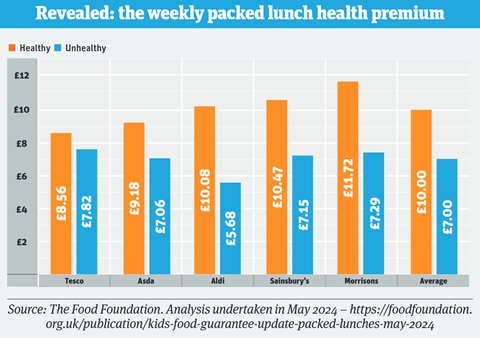
Parents pay an average premium of £3 per child per week to prepare healthy packed lunches, according to an analysis of prices in the top five supermarkets by health charity The Food Foundation.
In May, a healthy packed lunch – two slices of brown bread with spread, cheese, houmous, carrots, cucumber, apple, banana, plain yoghurt and a bag of popcorn – averaged £10 in the big five.
An unhealthy packed lunch – comprising two slices of white bread with chocolate spread, a cheese snack, a chocolate biscuit bar, fruit-flavoured fromage frais and a bag of ready salted crisps – averaged £7.
The difference in price varies significantly by retailer. It is smallest at Tesco, where the cost of a week of unhealthy lunches comes in at £7.82, versus £8.56 for a week of healthy lunches. That’s a premium of 9%.
At the other end of the spectrum is Aldi, where healthy lunches cost 77% more per week than unhealthy ones. The less healthy option is £5.68 at Aldi, by far the lowest in the big five. A more nutritious meal costs £10.08.
The average weekly cost of healthy packed lunches rose from £9.59 per child in August last year to £10 in May. That’s a rise of 4.3%. Again, price rises varied across retailers, with the lowest price hike seen in Tesco (2%) and the highest in Sainsbury’s (7.9%).
The Food Foundation has called on the supermarkets to implement meal deals on healthy lunch items. None of the big five said they were planning to introduce such deals when we asked them this week.
Asda and Morrisons did not respond. Tesco and Sainsbury’s both said they were committed to providing affordable healthy food. Aldi noted its selection of fruit & veg as evidence of its commitment to providing healthy food at affordable prices.
An Aldi spokesman said: “Aldi has been officially named the UK’s cheapest supermarket for three years… and our promise [is] significant savings.”

The Food Foundation is a UK-based charity that aims to change food policy and business practice to ensure people across the nation can afford and have access to a healthy and sustainable diet. It supports projects to improve children’s diets, increase vegetable consumption, influence food policy and inspire change in food business and investment.
‘Healthy’ bread
As far as other lunchbox items go, deciding what’s healthy is not always straightforward. Take white bread. It’s on The Food Foundation’s list of unhealthy lunch items.
But brands insist not all white bread is equal. “Hovis Best of Both combines the great taste of white bread with wholemeal flour, offering a product that is rich in calcium while delivering a source of fibre,” says Alistair Gaunt, commercial director at Hovis.
Gaunt also points to Hovis Tasty Wholemeal as a popular choice in both kids’ and adult lunches. “Providing a balanced diet and great taste are key considerations for parents… Qualitative research shows that health is a key driver for shoppers buying into brown bread [Hovis research September 2023].”
Whether brown bread is actually healthy depends on who you talk to, though. Heavily processed foods such as bread and cereals are defined by some as UPFs.
However, a WHO-backed study published in The Lancet in November found bread and cereal can cut the risks associated with an unhealthy diet because they contain fibre, a nutrient lacking among 90% of Brits [FDF].
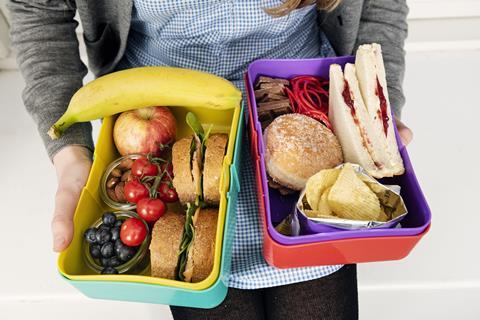
Hitting the 5 a day
Fibre isn’t the only thing missing from diets. “Currently, only 18% of UK children hit their 5 a day target, and this is a dial we are working hard to shift,” says Steph Armstrong, marketing manager at kids’ fruit snacks brand Bear, citing 2024 research carried out by the consultancy Truth Agency for the brand.
“As the category leader in kids fruit snacking, with 38.9% value market share [Circana 52 w/e 18 May 2024], everything we do is to make fruit & veg as appealing as possible for little ones, and lunchboxes are an important opportunity to do this.”
“I felt let down by the high levels of sugar in so many supposedly better-for-you snacks”
There are plenty more on the same mission. In 2021, Bel UK completed its acquisition of fruit smoothies snack pouches brand GoGo Squeez. It suggests retailers should feature these in the sort of meal deals recommended by the Food Foundation alongside Babybel and Laughing Cow. Another example is oat smoothies brand Three Robins, which launched two new lines in June.
“As a mum I was frustrated by the lack of quality options on shelf,” says Karen Robinson, who founded the brand in 2022. “I felt let down by the high levels of sugar in so many supposedly better-for-you snacks, and the limited range of nutritious, plant-based kids treats.”
Not that fruit yoyos and smoothies alone will solve the obesity problem. Most health-orientated products carry a hefty premium, and childhood obesity is almost twice as prevalent in the most deprived areas of England than the least deprived areas [NHS]. After all, parents on the breadline aren’t likely to fork out for smoothies that cost nearly £2 a pop.
That brings us back to the points made by The Food Foundation. As a wholesale change, it’s urging government to extend free school meals to all primary school pupils. But “in the meantime, we’re calling on supermarkets to ensure they sell healthy, convenient lunch items at affordable prices”.
Over to you, retailers.
Growing calls to extend free school meals
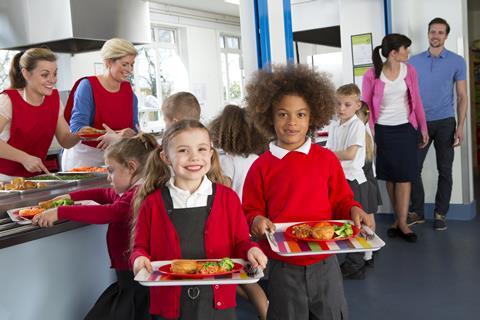
There’s no such thing as a free lunch, the saying goes. In 2014, when free school lunches were introduced for all kids in reception and years one and two in England, the scheme was said to be costing taxpayers £600m a year. It was also expected to save parents £400 a year.
But it wasn’t only about pounds. “There’s a real need to address health problems that are linked to a poor diet – almost 20% of children are obese by the time they leave primary school,” according to the UK government website on the scheme.
“A common misconception is that a packed lunch is healthier than a school meal. In fact, only 1% of packed lunches meet the nutritional standards that currently apply to school food.”
Despite this, childhood obesity has continued to rise over the past decade. But rather than writing the free school meals scheme off as a failure, many say it hasn’t made a dent on the nation’s weight problem because it doesn’t go far enough. Calls are growing for the extension of free meals to all primary school pupils in England.
“All schoolchildren should have access to a hot, nutritious meal from their school canteen each day,” says Shona Goudie, policy & advocacy manager at health charity The Food Foundation.
“However, in England, not all children get this and 900,000 children living in poverty across the country do not qualify for the government’s free school meals scheme.”
This means many are filling up on cheap junk food, says the charity. More than one in five (22.7%) kids were obese when they began secondary school in England last year.
Although that’s down on the heights seen after the first year of lockdown (25.5%), it’s still higher than the 21% who were obese pre-pandemic [NHS].
Yet, neither Labour nor the Tories have committed to extending the scheme in England. The Lib Dems are the only major party to have done so.
Downloads
Focus On Lunchbox kids
PDF, Size 19.67 mb









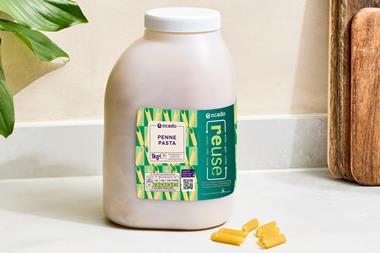
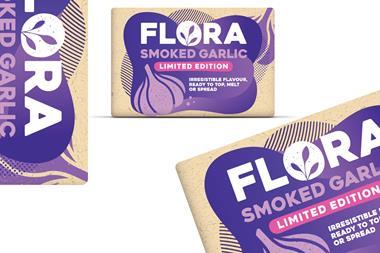
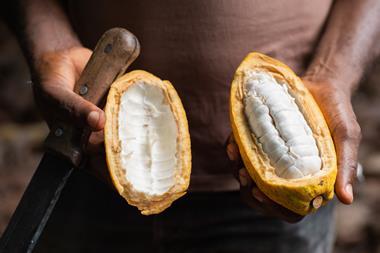

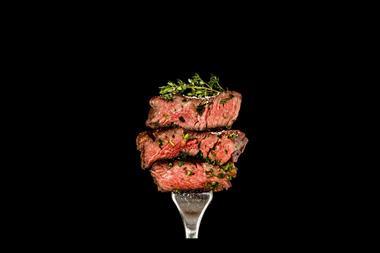
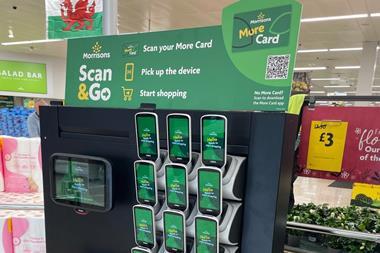
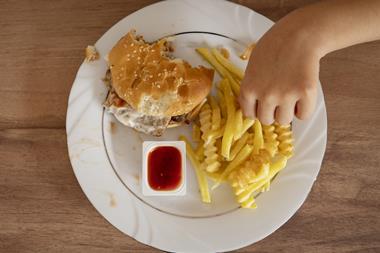
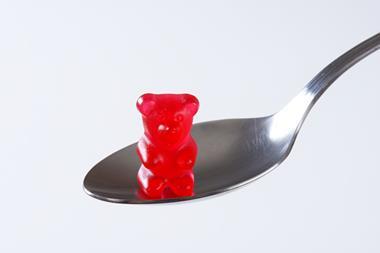

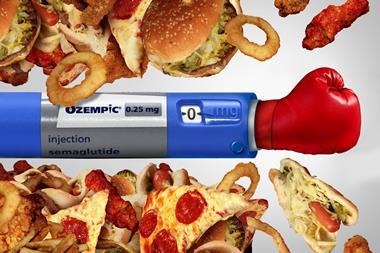
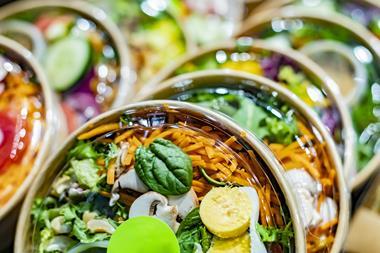

No comments yet